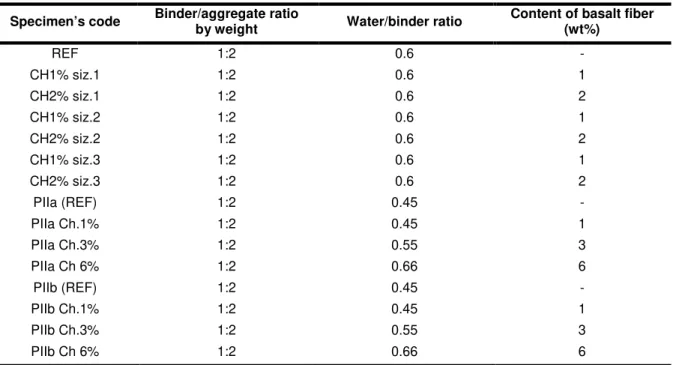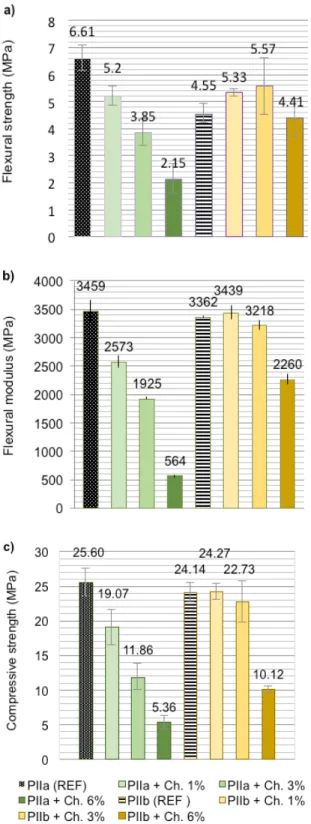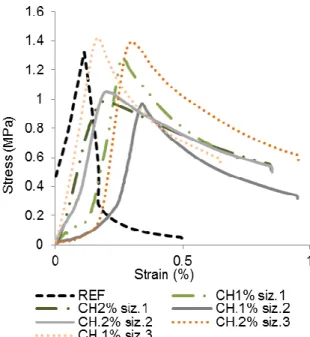First International Conference on Bio-based Building Materials June 22nd - 24th 2015 Clermont-Ferrand, France
BASALT FIBER AS REINFORCEMENT FOR LIME-BASED MORTARS
G. Quattrociocchi1*, M. Valente1, F. Sarasini1, J. Tirillò 1; M.L. Santarelli 1,21 Dipartimento di Ingegneria Chimica Materiali Ambiente, Sapienza University, Rome, Italy 2 CiSTEC – Centro di ricerca in scienza e tecnica per la conservazione del patrimonio
storico-architettonico, Rome, Italy
*Corresponding author; e-mail: gaia.quattrociocchi@uniroma1.it
Abstract
Natural fibers have been used in order to upgrade workability and toughness of concrete, mortars, and even bricks since early history, but they have ever shown problems related to their durability and resistance against bio-deterioration. After the building science revolution consisting of cement concretes, the use of traditional natural lime concrete and mortars sensibly diminished. Materials of tradition have been recently re-discovered due to their bio-compatibility, but their performances are still inferior to the ones of cement concrete. The present overall research aims at the improvement of mechanical and physical characteristics of traditional natural materials such as lime-mortars and concrete through the use of different types of natural fibers. Amongst the possible natural fibers, basalt ones were chosen as first case study because of the excellent results shown in other applications, their quite recent entrance into the industrial market and their environmentally friendly character. The purpose of this phase of the research was the optimization of the content and type of basalt fibers necessary to improve the behavior of a traditional natural hydraulic lime-mortar. It is well known that the incorporation of short fibers in mortar and concrete products can reduce plastic shrinkage, as well as improve some of their properties such as toughness, flexural strength and durability. Samples of a natural hydraulic lime (NHL) based mortar studied in comparison with ones mixed using cement as binder have been prepared and investigated through physico-mechanical tests as per Italian and European regulations. The results of this preliminary step will be used to perform the subsequent phases, including the assessment and comparison of the effects of several commercial types of fibers on mechanical and chemical properties of the ensuing mortars.
Keywords:
fiber-reinforced mortars, basalt fibers, natural hydraulic lime mortars
1 INTRODUCTION
Because of the importance fulfilled by the hydraulic mortars as building material through thousands of years and their constant use in the architectural field even in a period when their properties were to be determined, they still have a primary role in this sector. With the introduction of the cement as the most common hydraulic binder in the construction field, materials of tradition such as aerial and hydraulic lime knew a progressive decrease in their usage. Nonetheless, they continued to be used in fields where special attention has to be paid to the compatibility of materials with the ones of tradition as per the conservation of architectural monuments [Lanas 2004], gaining a specific sectorial space in the restoration market; and more relevant, in fields where special attention is paid to the environment. Considering the will of reducing greenhouse gas emissions connected with cement production [The European Cement Association 2011], lime-binders are valid alternative,
having a lower firing temperature than Portland cement, and causing low emissions of CO2 and
greenhouse gases. In any case, lime-based mortars show low mechanical properties in comparison with Portland cement-based ones, and brittle nature with additional limitations concerning the shrinkage cracking lead to a subsequent reduction in their full exploitation. These restrictions can be effectively dealt with through the use of fiber reinforcement, which is a common practice in cement-based materials [Boghossian 2008; Hannant 1995]. It has to be said that fibers of biological nature (plant-based and animal-based) have been historically used as addition to traditional mortars with all the possible limitations due to undesired interfacial reactions resulting in a decrease of strength and toughness as a result of weakening of the fibers [Toledo Filho 2003]. However, in the literature only a few deal with the addition of fibers in lime-based mortars especially with the addition of natural fibers of mineral origin [Asprone 2014]. Unlike biological fibers, natural fibers of mineral origin do not have limitations related to their durability
ICBBM 2015 and respect to the synthetic ones represent a
non-expensive and sustainable approach. Amongst the various possible natural fibers to be taken in consideration in the initial phase of the present research, the choice of basalt ones (which are continuously extruded from high temperature melt of selected basalt stones, which are volcanic, over-ground, effusive rocks saturated with 45–52% SiO2) is due to the current need for sustainable and energy efficient construction materials, a need which led to examination of alternative materials able to reduce the cost and environmental impact [De Fazio 2011; Sim J. 2005].This attention has initiated detailed studies of characteristics and properties of a mortar based on eminently natural hydraulic lime (NHL 5) reinforced
with basalt fibers in comparison with mortars based on two types of the most common Portland cement in the European market. It should be said that the research on the Portland cement-based mortars has been preliminary to the one on the NHL 5 ones. In fact, different amounts of basalt fibers were tested in order to select the best content necessary to improve the overall characteristic of the mortar [Santarelli 2014a]. This study is only preliminary to a more complete research including the microstructural study of the behavior of the fibers at the interface with the matrix and the comparison with several other commercial types of fibers indicated by the suppliers for the same function.
Tab. 1: Composition of the analyzed fiber reinforced mortars. Specimen’s code Binder/aggregate ratio
by weight Water/binder ratio
Content of basalt fiber (wt%) REF 1:2 0.6 - CH1% siz.1 1:2 0.6 1 CH2% siz.1 1:2 0.6 2 CH1% siz.2 1:2 0.6 1 CH2% siz.2 1:2 0.6 2 CH1% siz.3 1:2 0.6 1 CH2% siz.3 1:2 0.6 2 PIIa (REF) 1:2 0.45 - PIIa Ch.1% 1:2 0.45 1 PIIa Ch.3% 1:2 0.55 3 PIIa Ch 6% 1:2 0.66 6 PIIb (REF) 1:2 0.45 - PIIb Ch.1% 1:2 0.45 1 PIIb Ch.3% 1:2 0.55 3 PIIb Ch 6% 1:2 0.66 6
2 MATERIALS AND METHODS 2.1 Mortars
Considering both lime-based and cement-based mortars, nine different mixtures of hydraulic mortars were prepared with the addition of basalt fibers differing in sizing or content. With regard to the lime based mortars, an eminently natural hydraulic lime (henceforth labeled NHL 5) in compliance with European Norm [UNI EN 459-1:2010] and supplied by St. Astier was chosen for its hydraulic and mechanical properties. Seven different NHL 5 based mortars were prepared with the addition of three different types of basalt fibers, obtained from continuous filament roving chopped at 6.4 mm with a diameter of 13 µm characterized by three different sizings (CH. siz.1; CH. siz.2; CH. siz.3) indicated for specific use in concrete and supplied by Incotelogy GmbH.
The fibers were added in two percentages, namely 1% and 2% by weight to the mixture while specimens of neat mortar were used as control (REF). The addition of fibers was scheduled after preliminary tests on cement mortars (visible as comparison) prepared with two different products of the most common Portland cement commercially used on the
Italian market [The European Cement Association, 2013], namely Type II/b Portland limestone cement in accordance with European standard [EN 197-1: 2011], supplied by Buzzi (henceforth labeled as “PIIa”) and by Italcementi (hereafter labeled as “PIIb”). PIIa is indicated as cement for structural uses while PIIb is described as cement for renewal applications. The basalt fibers added to the matrix were supplied by Basaltex NV, and consist of BSC D-L-WET, basalt continuous filament roving chopped (Ch.) to a length of 6.35 mm, filament diameter in the range 10-19 µm with a silane sizing. Basalt fibers were added to the cement mortars at three different weight contents (1%, 3% and 6%) while specimens of neat mortars were used as control (PIIa REF, PIIb REF). The binder to aggregate ratio for all the mortars was chosen as 1:2 (by weight) with siliceous sand with a particle size range between 250-600 µm as aggregate. The workability and dispersion of fibers were preliminary assessed using different mixing parameters in order to determine the best working condition.
As regards the water content, the addition of water to the binder was determined through tests of workability with addition of fibers in accordance with italian regulation [uni en 1015-4:2000]. Three mortar specimens of dimensions 160 mm x 40 mm x 40 mm
were prepared per each formulation [uni en 1015-11:2007]. Specimens of mortars were cured in the proper environment for 28 days as per italian and european regulations [uni en 1015-1:2007 and uni en 196-1 2005]. The formulations of materials under investigation are summarized in table 1.
2.2 Analysis of the raw materials
The hydraulic binders were studied through thermogravimetric analysis (TGA) performed using a SDT Q600 (TA Instruments) with platinum crucibles at 10°/min heating rate in air flow (50 ml/min) from 30 °C to 1000 °C and their compositions were reported elsewhere [Santarelli 2014b]. The grain size of siliceous aggregate was analyzed by mechanical sieving as per standard [UNI EN 1015-1:2007]. 2.3 Mechanical characterization
Mechanical characterization of the mortars was carried out on a Zwick/Roell Z010 universal testing machine equipped with a 10 kN load cell in accordance with Italian and European standards [UNI EN 1015-11: 2007]. Three-point flexural tests were performed on three specimens for each configuration with a support span of 120 mm, a cross-head speed of 2 mm/min and a pre-load of 5 N. A displacement transducer was placed at the span center to measure the beam center deflection in order to evaluate the elastic modulus of the mortars. Compression strength test was carried out on the two fragments of each specimen resulting from the previous flexural test on an Instron 8033. 2.4 Water absorption
Permeability has a major role in the durability of a building material [Zhang 2014] and in order to assess differences in the behavior between the matrix and reinforced samples, water absorption was measured on one portion of each specimen resulting from the flexural tests in accordance with regulation [UNI EN 1015-18:2004].
3 RESULTS AND DISCUSSION
Preliminarily were tested the cement based mortars in order to determine a proper comparison for the lime-based ones. The choice of addition of different contents of fibers to the matrix was mainly due to the need of scheduling the subsequent operations; therefore additions of percentages such as 1% and 2% by weight were carefully decided after a wider range of additions was studied. Mechanical tests on the cement-based specimens allowed to investigate the potential reinforcement effect of basalt fibers with a view to determining an optimum content that, as can be seen from figure 2, should not exceed 3wt%. As regards NHL 5 based specimens mechanical characterization shows how the addition of fibers modifies the overall behavior of the material depending on type of sizing and content of basalt fibers, as summarized in figure 3. The response of the materials to the state of stress can be gathered in groups in function of the different sizing. This point leads to the need of further investigations on the differences amongst the functional groups of the various sizings used so as to identify their best application in conglomerates. As an overall consideration, the addition of fibers in case of lime-based mortars is not effective in the improvement of the static properties of the matrix.
Fig. 1: Fractured surfaces of the various types of specimens a) REF; b) CH 1% siz.1; c) CH. 2% siz. 1;
d)CH. 1% siz.2; e)CH. 2% siz. 2; f) CH. 1% siz.3; g) CH. 2% siz. 3)
Only the addition of 1% of fibers for sizing type 3 shows a very slight improvement but not in the elastic modulus. In the other two cases there is a slight decrease of the values (Fig. 3 a and b). Nonetheless, the chopped fibers are effective in modifying the brittle characteristic of the neat mortars, showing a significant post peak softening behavior due to a toughening effect as visible in the stress-strain curves reported in figure 4.
Fig. 2: Flexural strength (a), flexural modulus (b) and compressive strength (c) for cement-based samples
as a function of basalt fiber content.
Fig. 3: Flexural strength (a), flexural modulus (b) and compressive strength (c) for NHL 5-based specimen as a function of sizing and content of basalt fibers.
Fig. 4: Typical flexural behavior of mortars as a function of sizing and content of basalt fibers.
Fig. 5: Water absorption of mortars reinforced with different chopped fibers in different contents. In the curve of absorbed water (figure 5) is visible how the difference in the behavior of the reinforced samples and the reference decreased in function of time, indicating that the chopped fibers do not highly modify the permeability of the mortar.
Also in this case we have variations of the specimen behaviors in function of the sizing. In fact the samples reinforced with chopped fibers with sizing 2 show a higher index of capillarity in comparison with the other samples and the reference.
The differences amongst the different behaviors with a general best performance of the mortars reinforced with chopped fibers with sizing 3 and a worst performance with the addition of chopped fibers with sizing 2 could be explained by a different efficiency of the fibers to be dispersed within the matrix. This could cause a different porosity in the specimens in function of the different sizing, which leads also to a higher index of water absorption.
This difference in the fiber dispersion can be seen also on the fractured surfaces as per figure 6. One of the main problems emerged during the experimental work is the homogeneous dispersion of fibers in the matrix, which may be function of the chemical affinity of the fiber surfaces to the matrix and will be object of next studies.
4 CONCLUSIONS
Three different basalt fibers at various weight contents have been added to a hydraulic lime based mortar aiming at modifying its properties. As a comparison and starting point, the behavior of two cement based mortars reinforced with the same morphology of fiber was investigated. Mechanical properties were studied through bending and compression tests and the results confirmed that basalt fibers affect the behavior of the reference mortars. The following conclusions can be drawn: • fiber reinforcement, in the form of chopped fibers,
was effective in imparting post-peak stress carrying ability to mortars in flexure regardless of the nature of the hydraulic binder and of the content. The chopped fibers were not found suitable for strength enhancement in flexure. Compressive properties of neat mortars do not significantly increase with the addition of basalt fibers;
• the mechanical properties should be further investigated in terms of fracture and damage mechanisms which might highlight the role of interfaces between the basalt fibers and the mortars finding out a balance between the strength and toughness enhancement.
5 ACKNOWLEDGMENTS
Special thanks to Marta Albè and Sara Colandrea for their help in the experimental activities.
6 REFERENCES
Asprone, D., Cadoni, E., Ioculano, F., Prota, A., Analysis of the strain-rate behavior of a basalt fiber reinforced natural hydraulic mortar. Cement and Concrete Composites, October 2014, 53, 52–58. Boghossian, E., Wegner, L.D., Use of flax fibres to reduce plastic shrinkage cracking in concrete. Cement and Concrete Composites, 2008, 30, 929– 937.
De Fazio, P., Basalt fiber, from earth an ancient material for innovative and modern application. Energia, Ambiente e Innovazione, 2011, 3, 89-96. EN 197-1, Cement - Part 1, Composition, specifications and conformity criteria for common cements.
Hannant D.J., Fibre reinforcement in the cement and concrete industry. Materials Science and Technology, 1995, 11, 853-862.
Lanas, J., Pérez Bernal, J.L., Bello, M.A., Alvarez Galindo, J.I., Mechanical properties of natural hydraulic lime-based mortars. Cement and Concrete Research, December 2004, 34, 12, 2191–2201. Santarelli M.L. et al.(a) Malte più performanti con le fibre di basalto. Compositi Magazine, Settembre 2014, 7-16.
Santarelli, M.L. et al.(b) Basalt fiber reinforced natural hydraulic lime mortars, A potential bio-based
material for restoration, Materials and Design, 2014, 63, 398–406,
Sim, J., & Park, C., Characteristics of basalt fiber as a strengthening material. Composites, Part B, 2005, 36, 504–512.
The European Cement Association, The role of cement in the 2050 low carbon economy. 2011, Cembureau.
The European Cement Association, 2013 Activity Report. 2013, Cembureau.
Toledo Filho, R. D., Ghavami, K., England, G. L., Scrivener, K., Development of vegetable fibre–mortar composites of improved durability. Cement and Concrete Composites, 2003, 25, 185–96.
UNI EN 196-1: 2005. Metodi di prova dei cementi - Parte 1, Determinazione delle resistenze meccaniche.
UNI EN 459-1:2010. Calci da costruzione - Parte 1: Definizioni, specifiche e criteri di conformità
UNI EN 1015-1: 2007. Metodi di prova per malte per opere murarie - Parte 1: Determinazione della distribuzione granulometrica (mediante stacciatura) UNI EN 1015-4: 2000. Metodi di prova per malte per opere murarie - Determinazione della consistenza della malta fresca
UNI EN 1015-11: 2007. Metodi di prova per malte per opere murarie - Parte 11, Determinazione della resistenza a flessione e a compressione della malta indurita.
UNI EN 1015-18: 2004. Metodi di prova per malte per opere murarie - Determinazione del coefficiente di assorbimento d'acqua per capillarità della malta indurita.
Zhang, S.P.,Zong, L., Evaluation of Relationship between Water Absorption and Durability of Concrete Materials. Advances in Materials Science and Engineering, 2014.



